Choosing the Right Construction Method: A Comparative Study of Cost and Timeline for Top-Down and Bottom-Up Approaches
Abstract
:1. Introduction
1.1. Literature Review
1.2. Objectives and Scope
2. Materials and Methods
- Type 1: Represents structure models with a construction area of 40 m × 40 m;
- Type 1.1: Represents a model with a construction area of 40 m × 40 m and a depth of 8 m;
- Type 1.2: Represents a model with a construction area of 40 m × 40 m and a depth of 16 m;
- Type 1.3: Represents a model with a construction area of 40 m × 40 m and a depth of 24 m;
- Type 1.4: Represents a model with a construction area of 40 m × 40 m and a depth of 32 m;
- Type 1.5: Represents a model with a construction area of 40 m × 40 m and a depth of 40 m;
- Type 2: Represents structure models with a construction area of 80 m × 80 m;
- Type 2.1: Represents a model with a construction area of 80 m × 80 m and a depth of 8 m;
- Type 2.2: Represents a model with a construction area of 80 m × 80 m and a depth of 16 m;
- Type 2.3: Represents a model with a construction area of 80 m × 80 m and a depth of 24 m;
- Type 2.4: Represents a model with a construction area of 80 m × 80 m and a depth of 32 m;
- Type 2.5: Represents a model with a construction area of 80 m × 80 m and a depth of 40 m.
- Şişli, Istanbul has been chosen as the project construction site for the structure models;
- It is assumed that all structure models will be constructed on soft clayey and sandy soils;
- The structure models have completely symmetrical plan geometries;
- For the structures modelled using the top-down construction method, the preferred load-bearing system consists of “bored steel column + reinforced concrete slab”;
- For the structures modelled using the bottom-up construction method, two different load-bearing systems have been preferred. One of them has a “reinforced concrete column + reinforced concrete slab,” while the other has a “steel column + reinforced concrete slab”;
- The foundation systems for the structures to be built using the top-down and bottom-up construction methods consist of secant piles and raft foundation, respectively;
- All models of the structures to be built using the top-down and bottom-up construction methods have excavation support systems, and it is assumed that the same system is used in all of them. The excavation support system applied in the structure models consists of steel diaphragm walls and steel bracing elements;
- In the construction of all models according to the top-down and bottom-up construction methods, only rough construction cost and duration have been taken into account. Since the construction work and quantities within the structures to be used in both techniques will be the same, the data obtained will not affect the cost and duration comparison. Therefore, detailed labor, mechanical, and electrical work items have not been considered in the calculations;
- It is assumed that the steel bars and profiles used in the structure models are supplied from İçdaş factory in Bağcılar, Istanbul, and the bored and steel columns are supplied from Rainham Steel in the United Kingdom;
- It is assumed that the same number of machinery and workers are employed during the construction stages of Type 1 and Type 2 structure groups;
- For the top-down construction method with a “bored steel column + reinforced concrete slab” load-bearing system, a total of 116 workers are employed, while for the bottom-up construction method with a “steel column + reinforced concrete slab” load-bearing system, a total of 228 workers are employed. For the bottom-up construction method with a “reinforced concrete column + reinforced concrete slab” load-bearing system, a total of 220 workers are employed;
- When developing the work plan and estimating project durations, the date of 1 January 2021 is assumed as the start date of each of the 10 underground models.
- Concrete, formwork, lightweight reinforcement, and heavy reinforcement quantities for rough construction;
- Diaphragm wall quantities for shoring systems;
- Steel strapping quantities to be used in shoring systems;
- Quantities of plunge steel columns.
3. Results
3.1. Costs of Structure Models
3.1.1. Costs of Type 1 Structure Group Models
3.1.2. Costs of Type 2 Structure Group Models
3.2. Project Durations of Structure Models
3.2.1. Project Durations of Type 1 Structure Group Models
3.2.2. Project Durations of Type 2 Structure Group Models
4. Discussion
5. Conclusions
- The bottom-up construction method proves to be the most cost-effective choice at a depth of 8 m, while the top-down method becomes increasingly advantageous as the depth increases;
- Variation in the structure’s base area has minimal impact on the cost disparity between the two methods;
- The top-down construction method consistently outperforms the other systems in terms of project duration for all 10 analyzed models;
- Similar to the cost results, the percentage increase in the base area does not significantly affect the difference in project duration.
- Site-Specific Assumptions: The study was conducted assuming Şişli, Istanbul as the project construction site, with soft clayey and sandy soils. These site-specific conditions may not fully represent the diverse geological and environmental factors encountered in other locations;
- Standardization of Structural Models: Although efforts were made to standardize the structural models for fair comparison, variations in construction techniques and site conditions may exist, potentially impacting the generalizability of the findings;
- Simplifications in Cost and Duration Estimations: Detailed labor, mechanical, and electrical work items were not considered in the cost and duration estimations. While this approach facilitated a broad comparison of the construction methods, it may overlook certain project-specific complexities and nuances;
- Assumptions Regarding Materials and Resources: The study assumed specific suppliers for materials and standardized labor resources, which may not accurately reflect real-world procurement processes and availability, particularly in different geographical regions;
- Scope of Analysis: Our analysis primarily focused on rough construction items and did not delve into detailed craftsmanship, mechanical, and electrical work items. Future studies may benefit from a more comprehensive examination of these aspects.
Author Contributions
Funding
Data Availability Statement
Conflicts of Interest
References
- Wong, J.Y.; Yip, C.C.; Mugumya, K.L.; Tan, B.H.; Anwar, M.P. Effectiveness of top-down construction method in Malaysia. Int. J. Innov. Technol. Explor. Eng. 2019, 8, 386–392. [Google Scholar]
- Prince, K.; Theertha, S.L.; Sujithom, S.; Zacheriah, J.; Kottuppillil, A.K. Comparison between top down construction method and bottom up construction method: Case study. Int. Res. J. Eng. Technol. 2020, 7, 5844–5850. [Google Scholar]
- Paek, J.H.; Ock, J.H. Innovative building construction technique: Modified up/down method. J. Constr. Eng. Manag. 1996, 122, 141–146. [Google Scholar] [CrossRef]
- Arboleda-Monsalve, L.G.; Finno, R.J. Influence of concrete time-dependent effects on the performance of top-down construction. J. Geotech. Geoenviron. Eng. 2015, 141, 04014120. [Google Scholar] [CrossRef]
- Tuan, B.Q.; Tam, N.M. Semi top-down method combined with earth-bank, an effective method for basement construction. In IOP Conference Series: Earth and Environmental Science; IOP Publishing: Bristol, UK, 2018; p. 012047. [Google Scholar]
- Rojhani, M.; Bayesteh, H. Innovative Top-down construction method with a sequential peripheral wall. Geotech. Geol. Eng. 2023, 41, 1777–1799. [Google Scholar] [CrossRef]
- Tang, Y.; Zhao, X. Field testing and analysis during top-down construction of super-tall buildings in Shanghai. KSCE J. Civ. Eng. 2016, 20, 647–661. [Google Scholar] [CrossRef]
- Agrawal, N.S.; Harne, V.; Chouhan, J.; Gangwani, L. Construction of plunge column by using top down construction method. Helix-Sci. Explor.|Peer Rev. Bimon. Int. J. 2020, 10, 170–173. [Google Scholar] [CrossRef]
- Long, M. Database for retaining wall and ground movements due to deep excavation. J. Geotech. Geoenviron. Eng. 2001, 127, 203–224. [Google Scholar] [CrossRef]
- Puller, M. Deep Excavations—A Practical Manual, 2nd ed.; Thomas Telford Ltd.: London, UK, 2003. [Google Scholar]
- Li, M.G.; Chen, J.J.; Xu, A.J.; Xia, X.H.; Wang, J.H. Case study of innovative top-down construction method with channel-type excavation. J. Constr. Eng. Manag. 2014, 140, 05014003. [Google Scholar] [CrossRef]
- Ren, Q.; Zhao, Q.; Liu, W.; Yang, S.; Li, S.; Yang, J.; Peng, F. Design and top-down construction at the Nanjing Youth Olympic Center, China. Proc. Inst. Civ. Eng.-Civ. Eng. 2016, 169, 65–70. [Google Scholar] [CrossRef]
- Kim, S.H.; Yom, K.S.; Choi, S.M. Stress-transfer in concrete encased and filled tube square columns employed in top-down construction. Steel Compos. Struct. 2016, 22, 63–77. [Google Scholar] [CrossRef]
- Wang, Y.; Pan, X.; Xu, H.; Liu, J.; Li, P.; He, L.; Zhang, W. Characteristics analysis for high-rise buildings during top-down construction. J. Civ. Eng. Manag. 2024, 30, 326–342. [Google Scholar] [CrossRef]
- Liu, Y.; Li, J.P.; Chen, W. Key construction techniques for oversized excavation pits using top-down method. Chin. J. Geotech. Eng. 2013, 35, 489–494. (In Chinese) [Google Scholar]
- Wang, Y.G. Design and Case Studies for Top-Down Method Construction; China Architectural and Building Press: Beijing, China, 2011. (In Chinese) [Google Scholar]
- Rhim, C.H.; Kim, K.M.; Kim, S.W. Development of an optimum pre-founded column system for top-down construction. J. Civ. Eng. Manag. 2012, 18, 735–743. [Google Scholar] [CrossRef]
- Findlay, J.D.; Wren, G.E. Review of the methods used to construct large diameter bored piles for top down construction. In Proceedings of the International Conference on Piling and Deep Foundations, London, UK, 15–18 May 1989; pp. 199–210. [Google Scholar]
- Hollingsworth, J.R. Diaphragm walls load bearing piles and piled soil reinforcement for a deep top-down basement construction. In Proceedings of the 4th International DFI Conference, Rotterdam, The Netherlands, 7–12 April 1991; pp. 79–84. [Google Scholar]
- Crawley, J.D.; Stones, C.S. Westminister station deep foundation and top-down construction in central London. In Geotechnical Aspects of Underground Construction in Soft Ground; A.A. Balkema, Brookfield: Rotterdam, The Netherlands, 1996; pp. 93–97. [Google Scholar]
- Lui, J.Y.H.; Yau, P.K.F. The performance of deep basement for the dragon centre. In Proceedings of the Seminar on Instrumentation in Geotechnical Engineering; Hong Kong Institution of Engineers: Hong Kong, China, 1995. [Google Scholar]
- Lee, H.S.; Lee, J.Y.; Lee, J.S. Nonshored form work system for top-down construction. J. Constr. Eng. Manag. 1999, 125, 392–399. [Google Scholar] [CrossRef]
- Thasnanipan, N.; Aye, Z.Z.; Boonyarak, T.; Submaneewong, C. Application of top-down construction method for deep excavations in Bangkok. In Proceedings of the International Symposium on Underground Excavation and Tunneling, Bangkok, Thailand, 2–4 February 2006. [Google Scholar]
- Jamsawang, P.; Jamnam, S.; Jongpradist, P.; Tanseng, P.; Horpibulsuk, S. Numerical analysis of lateral movements and strut forces in deep cement mixing walls with top-down construction in soft clay. Comput. Geotech. 2017, 88, 174–181. [Google Scholar] [CrossRef]
- Ghorbani, E.; Khodaparast, M. Geodetic accuracy in observational construction of an excavation stabilized by top-down method: A case study. Geotech. Geol. Eng. 2019, 37, 4759–4775. [Google Scholar] [CrossRef]
- Yurkevich, P.B. Development Top-Down Method of Underground Construction or Hi-Tech in Russian; Yurkevich Engineering Bureau Ltd.: Moscow, Russian, 2003. [Google Scholar]
- Kara, A.; Chelliah, A.; Tzaveas, T. Top-down construction method: A case study for underpass structure in Qatar. In Proceedings of the 2nd International Conference on Civil Infrastructure and Construction (CIC 2023), Doha, Qatar, 5–8 February 2023. [Google Scholar]
- Wang, T.C.; Du, X.H.; Zhao, H.L. Numerical simulation of subway station constructed using top-down method. Adv. Intell. Syst. Res. 2012, 446, 3757–3761. [Google Scholar] [CrossRef]
- Basarkar, S.S.; Kumar, M.; Mohapatro, B.G.; Mutgi, P.R. Emerging trend in deep basement construction: Top-down technique. IOSR J. Mech. Civ. Eng. 2013, 1–11. Available online: https://www.iosrjournals.org/iosr-jmce/papers/sicete(civil)-volume5/50.pdf (accessed on 6 May 2024).
- Tan, Y.; Li, M.W. Measured performance of a 26 m deep top-down excavation in downtown Shanghai. Can. Geotech. J. 2011, 48, 704–719. [Google Scholar] [CrossRef]
- Nikiforova, N.S.; Mangushev, R.A.; Il’ichev, V.A. Development of underground space in large Russian cities. Soil Mech. Found. Eng. 2012, 49, 63–67. [Google Scholar]
- Sakharkar, R. Comparative study of top down & bottom up method construction schedule with respect to construction of a residential building. Int. Res. J. Eng. Technol. 2019, 6, 2233–2237. [Google Scholar]
- Ou, C.-Y.; Liao, J.-T.; Lin, H.-D. Performance of diaphragm wall constructed using top-down method. J. Geotech. Geoenviron. Eng. 1998, 124, 789–912. [Google Scholar] [CrossRef]
- Kung, G.T. Comparison of excavation-induced wall deflection using top-down and bottom-up construction methods in Taipei silty clay. Comput. Geotech. 2009, 36, 373–385. [Google Scholar] [CrossRef]
- Jia, J.; Xie, X.; Zhai, J.; Zhang, Y.Y.; Yang, K.; Guo, X.H. Research and design on top-down method for large scale podium basement excavation of shanghai tower. In GeoCongress 2012: State of the Art and Practice in Geotechnical Engineering; American Society of Civil Engineers: Reston, VA, USA, 2012. [Google Scholar]
- Tan, Y.; Wang, D. Characteristics of a large-scale deep foundation pit excavated by the central-island technique in shanghai soft clay. ii: Top-down construction of the peripheral rectangular pit. J. Geotech. Geoenviron. Eng. 2013, 139, 1894–1910. [Google Scholar] [CrossRef]
- Xiang, W.M.; Zheng, X.C.; Shen, K.P.; Zhou, M. Design of broad-columns joint and analysis of stress for top-down construction method of underground engineering. Adv. Mater. Res. 2012, 594–597, 1214–1218. [Google Scholar] [CrossRef]
- Kim, D.; Jeong, S.; Jung, G.; Park, J. Load-sharing ratio of prebored and precast pile in top-down method construction process. Struct. Des. Tall Spec. Build. 2018, 27, e1472. [Google Scholar] [CrossRef]
- Liang, R.; Wu, J.; Sun, L.; Shen, W.; Wu, W. Performances of adjacent metro structures due to zoned excavation of a large-scale basement in soft ground. Tunn. Undergr. Space Technol. 2021, 117, 104123. [Google Scholar] [CrossRef]
- Radovanovic, M.M.L.; Nikolic, J.Z.; Radovanovic, J.R.; Kostic, S.M. Structural behaviour of axially loaded concrete-filled steel tube columns during the top-down construction method. Appl. Sci. 2022, 12, 3771. [Google Scholar] [CrossRef]
- Zhu, Y.; Qin, H.; Zhang, X.; Wei, D.; Zhai, L.; Hu, L. Innovative three-row pile support system of ultra-deep foundation pit and cooperative construction technology with basement for high-rise tower structures. Buildings 2024, 14, 1003. [Google Scholar] [CrossRef]
- Kim, H.J.; Mission, J.L.C. Improved evaluation of equivalent top-down load-displacement curve from a bottom-up pile load test. J. Geotech. Geoenviron. Eng. 2011, 137, 568–578. [Google Scholar] [CrossRef]
- Chiu, H.W.; Hsu, C.F.; Tsai, F.H.; Chen, S.L. Influence of different construction methods on lateral displacement of diaphragm walls in large-scale unsupported deep excavation. Buildings 2023, 14, 23. [Google Scholar] [CrossRef]
- SAP2000 Version: 17.1.1. Structural Analysis Program; Computers and Structures Inc.: Berkeley, CA, USA, 2015; Available online: https://www.csiamerica.com/products/sap2000 (accessed on 6 May 2024).
- IdeCAD Statik Version 7.022; Ideyapi: İstanbul, Türkiye, 2013; Available online: https://idecad.com/ (accessed on 6 May 2024).


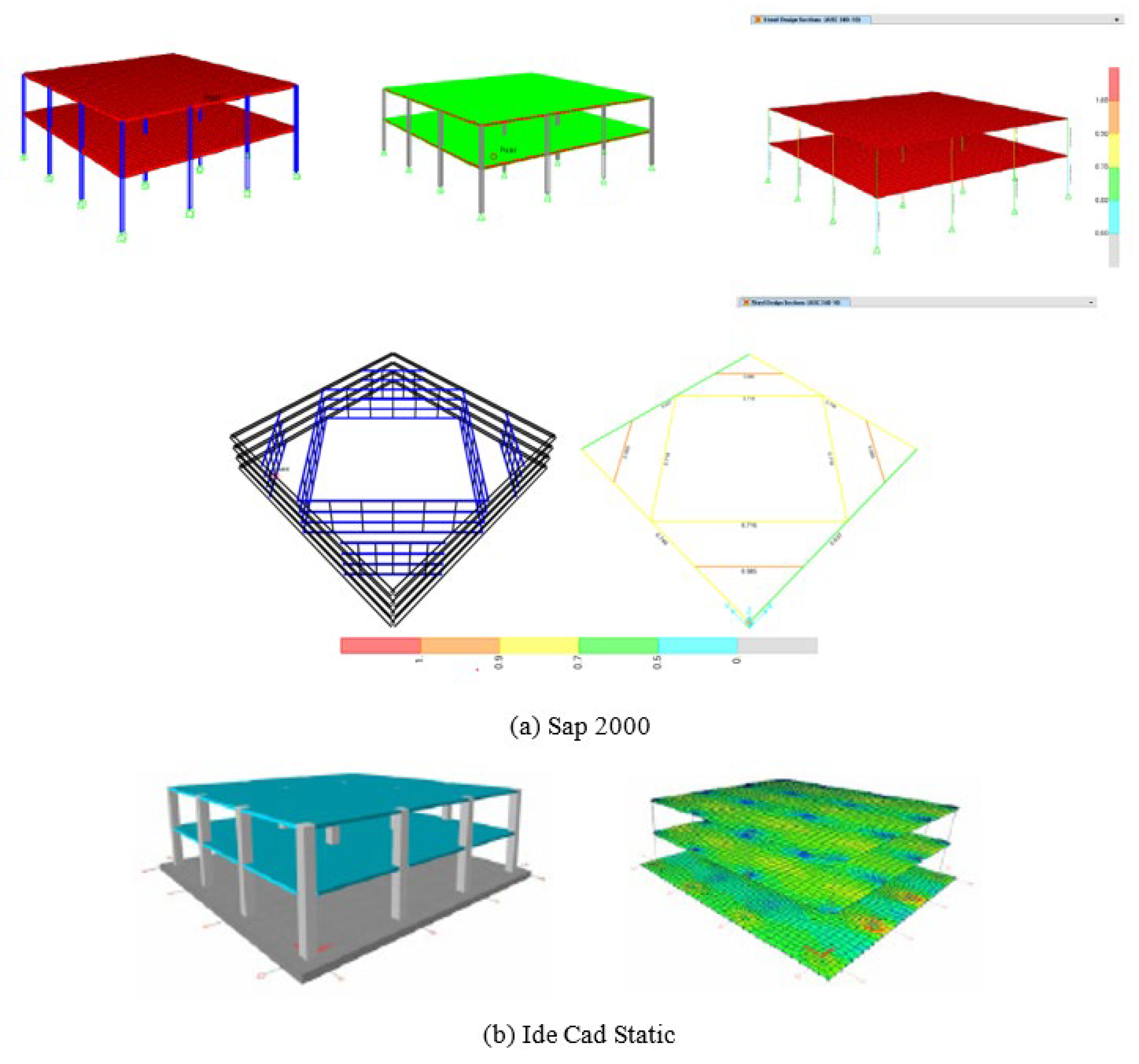

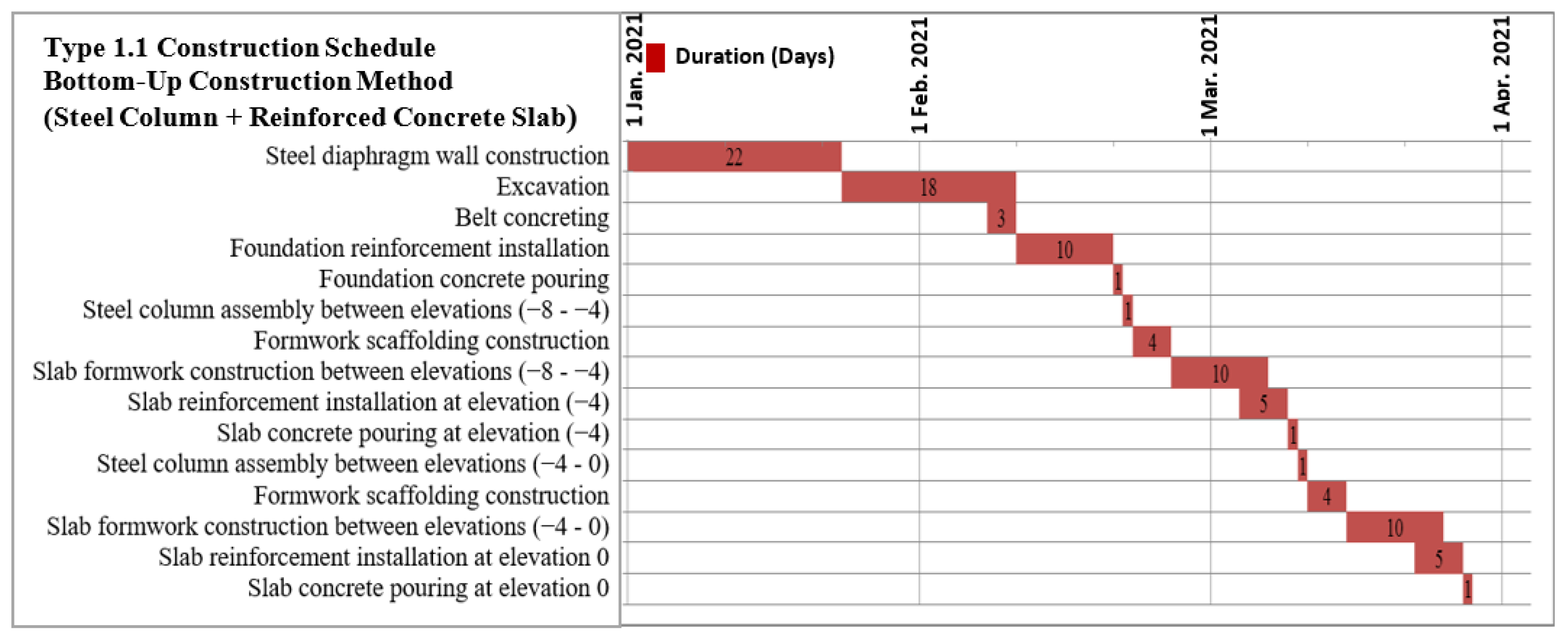
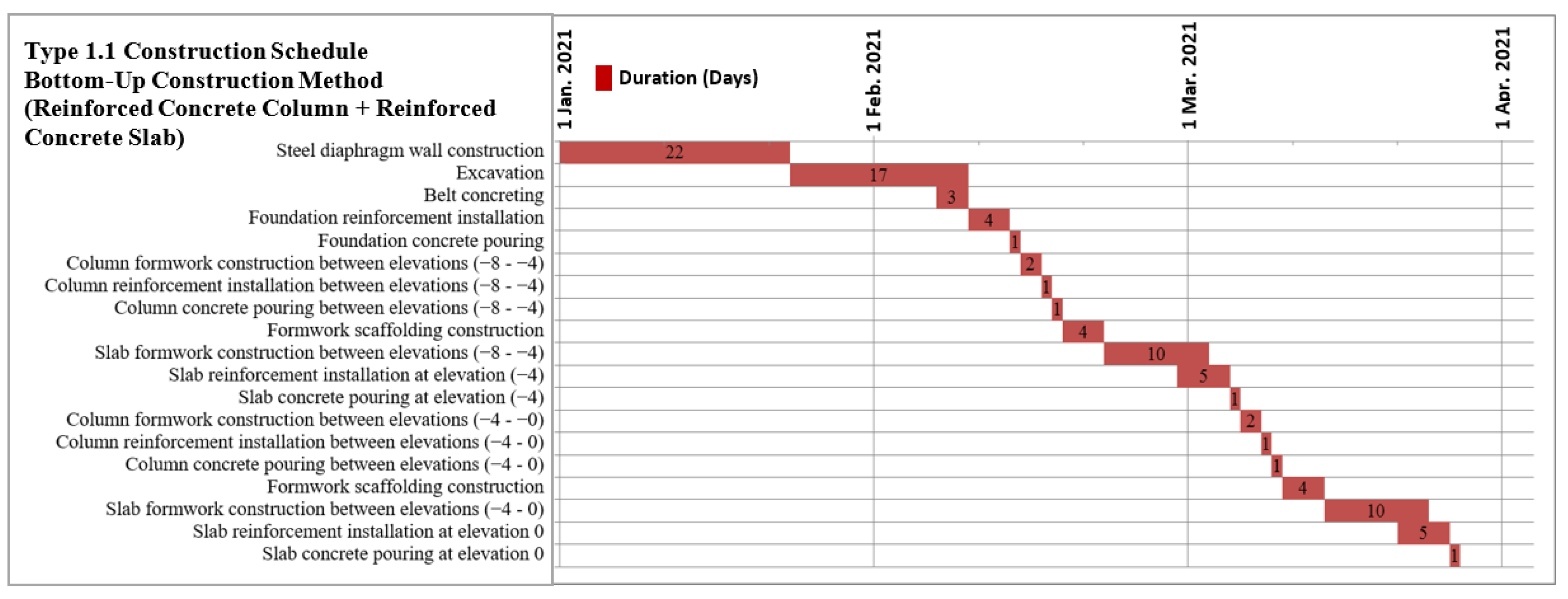
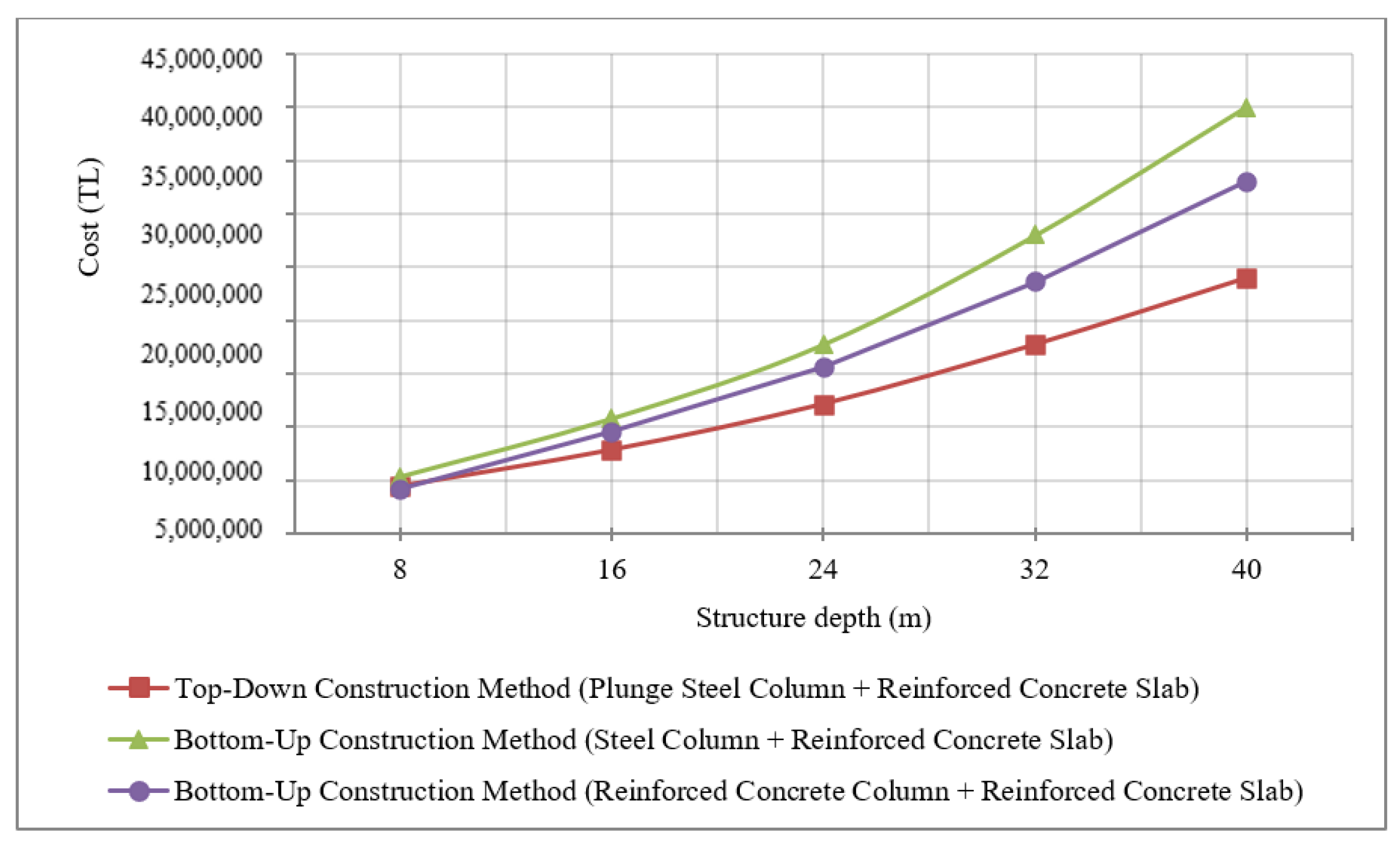
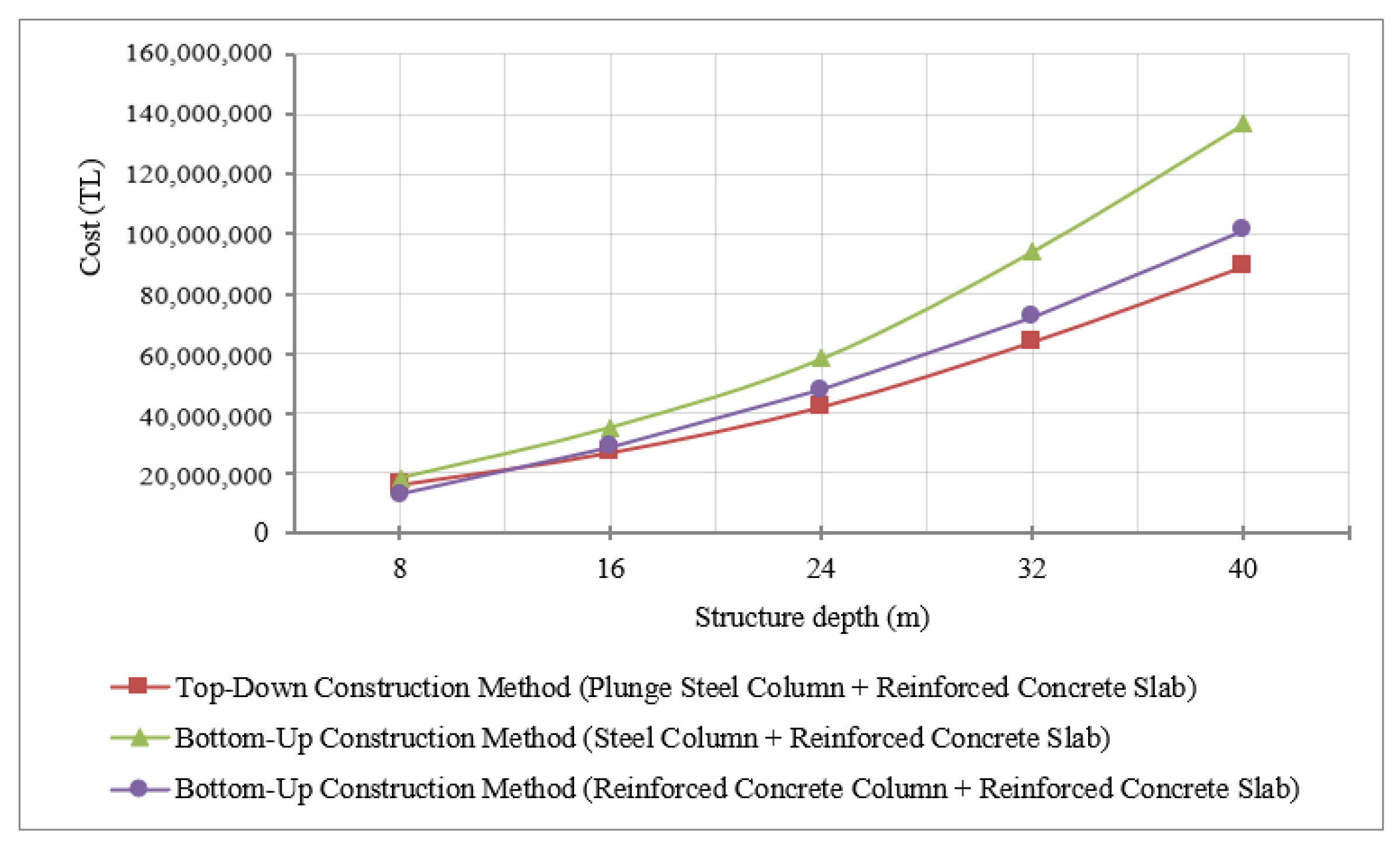


| Construction Method (Load-Bearing System) | Item No | Item Description |
|---|---|---|
| Top-Down (Steel plunge column + Reinforced concrete slab) | 1 | Steel diaphragm wall construction |
| 2 | Excavation for plunge column placement | |
| 3 | Fore pile works | |
| 4 | Steel plunge column assembly | |
| 5 | Slab reinforcement work | |
| 6 | Slab concrete pouring | |
| 7 | Excavation | |
| 8 | Mobile crane operation | |
| 9 | Steel transportation | |
| 10 | Profile transportation | |
| Bottom-Up (Steel column + Reinforced concrete slab) | 1 | Steel diaphragm wall construction |
| 2 | Excavation | |
| 3 | Strapping | |
| 4 | Foundation reinforcement work | |
| 5 | Foundation concrete pouring | |
| 6 | Steel column installation | |
| 7 | Formwork scaffolding construction | |
| 8 | Slab formwork construction | |
| 9 | Slab reinforcement work | |
| 10 | Slab concrete pouring | |
| 11 | Steel transportation | |
| 12 | Profile transportation | |
| Bottom-Up (Reinforced concrete column + Reinforced concrete slab) | 1 | Steel diaphragm wall construction |
| 2 | Excavation | |
| 3 | Strapping | |
| 4 | Foundation reinforcement work | |
| 5 | Foundation concrete pouring | |
| 6 | Column formwork construction | |
| 7 | Column reinforcement work | |
| 8 | Column concrete pouring | |
| 9 | Formwork scaffolding construction | |
| 10 | Slab formwork construction | |
| 11 | Slab reinforcement work | |
| 12 | Slab concrete pouring | |
| 13 | Steel transportation | |
| 14 | Profile transportation |
| No | Item No | Description | Material | Quantity | Unit | Unit Price (Turkish Liras, TL) | Total Cost (TL) |
|---|---|---|---|---|---|---|---|
| 1 | Special item 011 | Steel diaphragm wall construction | Larssen 25 steel profile | 1408.00 | m² | 1228.84 | 1,730,206.72 |
| 2 | 19.100.1058 | Excavation for plunge steel column | Foundation pile drilling machine (440 HP) | 60.16 | hour | 776.38 | 46,707.02 |
| 3 | 15.140.1209 | Pile construction | 120 cm diameter C30/37 class concrete | 240.00 | m | 1221.79 | 293,229.60 |
| 4 | Special item 001 | Plunge steel column installation | UC 305 × 305 × 240 steel column | 43.70 | ton | 20,629.46 | 901,507.40 |
| 5 | 15.160.1004 | Slab reinforcement installation | Ø16/15 ribbed bars | 197.89 | ton | 4362.90 | 863,356.83 |
| 6 | 15.150.1006 | Slab concrete casting | d = 30 cm C30/37 class concrete | 1440.00 | m³ | 262.38 | 377,827.20 |
| 7 | 15.120.1101 | Excavation | Soft and hard soil | 13,280.00 | m³ | 6.29 | 83,531.20 |
| 8 | KGM/03.587/3 | Mobile crane | 80-ton lifting capacity | 221.33 | hour | 750.56 | 166,123.95 |
| 9 | N.YF.07 | Transportation of steel | Ø8-Ø28 ribbed bars | 222.96 | ton | 7.79 | 1736.83 |
| 10 | N.YF.26 | Transportation of profiles | UC 305 × 305 × 240 steel column | 43.70 | ton | 810.31 | 35,410.55 |
| Total | 4,499,637.29 | ||||||
| Construction Method (Load-Bearing System) | Machine Type and Workforce | Number of Machines | Number of Workers |
|---|---|---|---|
| Top-down (Plunge Steel Column + Reinforced Concrete Slab) | Larssen steel profile driving machine | 4 | |
| Fore pile drilling machine (440 HP) | 2 | ||
| Fore pile construction team | 10 | ||
| Plunge steel column assembly team | 6 | ||
| Reinforcement installation team for slab | 80 | ||
| Concrete pouring team for slab | 20 | ||
| Excavator for subgrade excavation (0.3 m3 bucket) | 8 | ||
| 80-ton mobile crane | 1 | ||
| Total | 15 | 116 | |
| Bottom-up (Steel Column + Reinforced Concrete Slab) | Larsen steel profile driving machine | 4 | |
| Excavator for excavation (0.5 m³ bucket) | 8 | ||
| Banding steel assembly team | 15 | ||
| Foundation and slab reinforcement installation team | 80 | ||
| Concrete pouring team | 20 | ||
| Steel column assembly team | 8 | ||
| Formwork and scaffolding construction team | 45 | ||
| Slab formwork team | 60 | ||
| Total | 12 | 228 | |
| Bottom-up (Reinforced Concrete Column + Reinforced Concrete Slab) | Larsen steel profile driving machine | 4 | |
| Excavator for excavation (0.5 m3 bucket) | 8 | ||
| Banding steel assembly team | 15 | ||
| Foundation and slab reinforcement installation team | 80 | ||
| Concrete pouring team | 20 | ||
| Column formwork team | 60 | ||
| Column reinforcement team | 80 | ||
| Formwork and scaffolding construction team | 45 | ||
| Slab formwork team | 60 | ||
| Total | 12 | 220 |
| Activity No | Work Item | Start Date | Predecessor | Relationship | Duration (Days) |
|---|---|---|---|---|---|
| 1 | Steel diaphragm wall construction | 1 January 2021 | (-) | 22 | |
| 2 | Excavation for fore piles where plunge steel columns will be placed | 23 January 2021 | 1 | FS | 4 |
| 3 | Fore pile construction | 27 January 2021 | 2 | FS | 3 |
| 4 | Plunge steel column installation | 29 January 2021 | 3 | FF | 1 |
| 5 | Reinforcement installation for elevation 0 slab | 30 January 2021 | 4 | FS | 5 |
| 6 | Concreting of elevation 0 slab | 4 February 2021 | 5 | FS | 1 |
| 7 | Excavation for (elevation 0 to elevation 4) | 5 February 2021 | 6 | FS | 12 |
| 8 | Reinforcement installation for (−4) slab | 17 February 2021 | 7 | FS | 5 |
| 9 | Concreting of (−4) slab | 22 February 2021 | 8 | FS | 1 |
| 10 | Excavation for (elevation −4 to elevation −8) | 23 February 2021 | 9 | FS | 13 |
| 11 | Reinforcement installation for (−8) slab | 8 March 2021 | 10 | FS | 5 |
| 12 | Concreting of (−8) slab | 13 March 2021 | 11 | FS | 1 |
| Type | Structure Depth (m) | Start Date | Top-Down Construction Method (Plunge Steel Column + Reinforced Concrete Slab) | Bottom-Up Construction Method (Steel Column + Reinforced Concrete Slab) | Bottom-Up Construction Method (Reinforced Concrete Column + Reinforced Concrete Slab) | |||
|---|---|---|---|---|---|---|---|---|
| End Date | Project Duration (Days) | End Date | Project Duration (Days) | End Date | Project Duration (Days) | |||
| Type1.1 | 8 | 1 January 2021 | 14 March 2021 | 72 | 29 March 2021 | 87 | 28 March 2021 | 86 |
| Type 1.2 | 16 | 1 January 2021 | 15 May 2021 | 134 | 10 June 2021 | 160 | 18 June 2021 | 168 |
| Type 1.3 | 24 | 1 January 2021 | 16 July 2021 | 196 | 28 August 2021 | 239 | 6 Sep. 2021 | 248 |
| Type 1.4 | 32 | 1 January 2021 | 16 Sep. 2021 | 258 | 12 Nov. 2021 | 315 | 26 Nov. 2021 | 329 |
| Type 1.5 | 40 | 1 January 2021 | 17 Nov. 2021 | 320 | 6 Feb. 2022 | 401 | 25 Feb. 2022 | 420 |
| Type 2.1 | 8 | 1 January 2021 | 21 August 2021 | 232 | 11 Oct. 2021 | 283 | 23 Sep. 2021 | 265 |
| Type 2.2 | 16 | 1 January 2021 | 6 March 2022 | 429 | 31 May 2022 | 515 | 3 June 2022 | 518 |
| Type 2.3 | 24 | 1 January 2021 | 25 Sep. 2022 | 632 | 30 Jan. 2023 | 759 | 2 March 2023 | 790 |
| Type 2.4 | 32 | 1 January 2021 | 10 April 2023 | 829 | 25 Oct. 2023 | 1027 | 15 Nov. 2023 | 1048 |
| Type 2.5 | 40 | 1 January 2021 | 24 Oct. 2023 | 1026 | 24 July 2024 | 1300 | 11 August 2024 | 1318 |
| Type 1 40 m × 40 m | Structure Depth (m) | Top-Down Construction Method (Plunge Steel Column + Reinforced Concrete Slab) (TL) | Bottom-Up Construction Method (Steel Column + Reinforced Concrete Slab) (TL) | Bottom-Up Construction Method (Reinforced Concrete Column + Reinforced Concrete Slab) (TL) |
|---|---|---|---|---|
| Type 1.1 | 8 | 4,499,637.29 | 5,384,483.02 | 208,304.69 |
| Type 1.2 | 16 | 7,898,206.49 | 10,822,064.99 | 9,505,706.24 |
| Type 1.3 | 24 | 12,195,519.22 | 17,750,047.59 | 15,670,620.40 |
| Type 1.4 | 32 | 17,766,145.08 | 27,965,323.84 | 23,597,430.94 |
| Type 1.5 | 40 | 24,010,518.69 | 40,029,750.60 | 2,973,964.40 |
| Type 1 80 m × 80 m | Structure Depth (m) | Top-Down Construction Method (Plunge Steel Column + Reinforced Concrete Slab) (TL) | Bottom-Up Construction Method (Steel Column + Reinforced Concrete Slab) (TL) | Bottom-Up Construction Method (Reinforced Concrete Column + Reinforced Concrete Slab) (TL) |
|---|---|---|---|---|
| Type 2.1 | 8 | 15,894,655.22 | 18,183,952.81 | 12,918,897.01 |
| Type 2.2 | 16 | 26,665,439.65 | 35,164,930.18 | 28,963,152.09 |
| Type 2.3 | 24 | 41,985,859.39 | 58,125,960.18 | 47,925,676.12 |
| Type 2.4 | 32 | 63,752,323.52 | 94,062,502.50 | 72,330,234.13 |
| Type 2.5 | 40 | 88,929,574.67 | 136,826,816.87 | 101,317,586.56 |
Disclaimer/Publisher’s Note: The statements, opinions and data contained in all publications are solely those of the individual author(s) and contributor(s) and not of MDPI and/or the editor(s). MDPI and/or the editor(s) disclaim responsibility for any injury to people or property resulting from any ideas, methods, instructions or products referred to in the content. |
© 2024 by the authors. Licensee MDPI, Basel, Switzerland. This article is an open access article distributed under the terms and conditions of the Creative Commons Attribution (CC BY) license (https://creativecommons.org/licenses/by/4.0/).
Share and Cite
Meral, Ç.; Temel, B.A.; Başaga, H.B. Choosing the Right Construction Method: A Comparative Study of Cost and Timeline for Top-Down and Bottom-Up Approaches. Buildings 2024, 14, 2381. https://doi.org/10.3390/buildings14082381
Meral Ç, Temel BA, Başaga HB. Choosing the Right Construction Method: A Comparative Study of Cost and Timeline for Top-Down and Bottom-Up Approaches. Buildings. 2024; 14(8):2381. https://doi.org/10.3390/buildings14082381
Chicago/Turabian StyleMeral, Çetin, Bayram Ali Temel, and Hasan Basri Başaga. 2024. "Choosing the Right Construction Method: A Comparative Study of Cost and Timeline for Top-Down and Bottom-Up Approaches" Buildings 14, no. 8: 2381. https://doi.org/10.3390/buildings14082381
APA StyleMeral, Ç., Temel, B. A., & Başaga, H. B. (2024). Choosing the Right Construction Method: A Comparative Study of Cost and Timeline for Top-Down and Bottom-Up Approaches. Buildings, 14(8), 2381. https://doi.org/10.3390/buildings14082381







